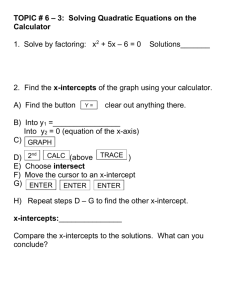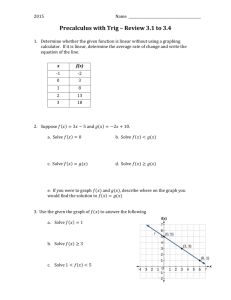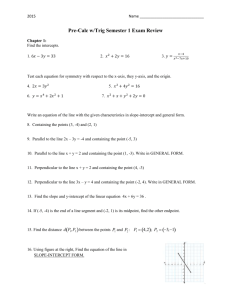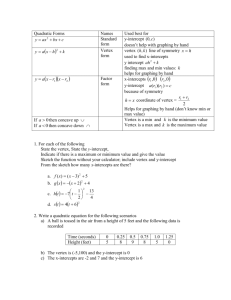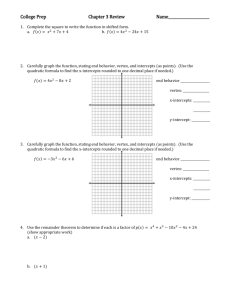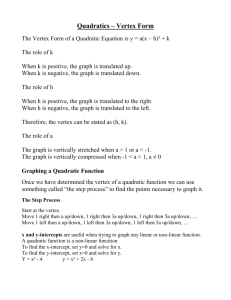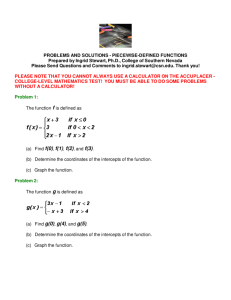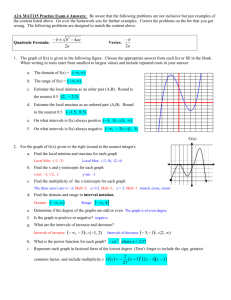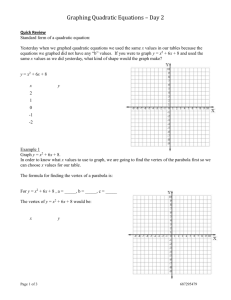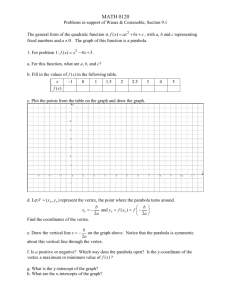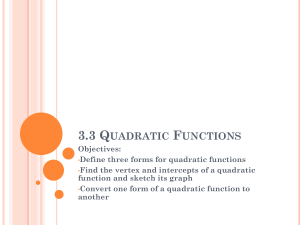section 8.7
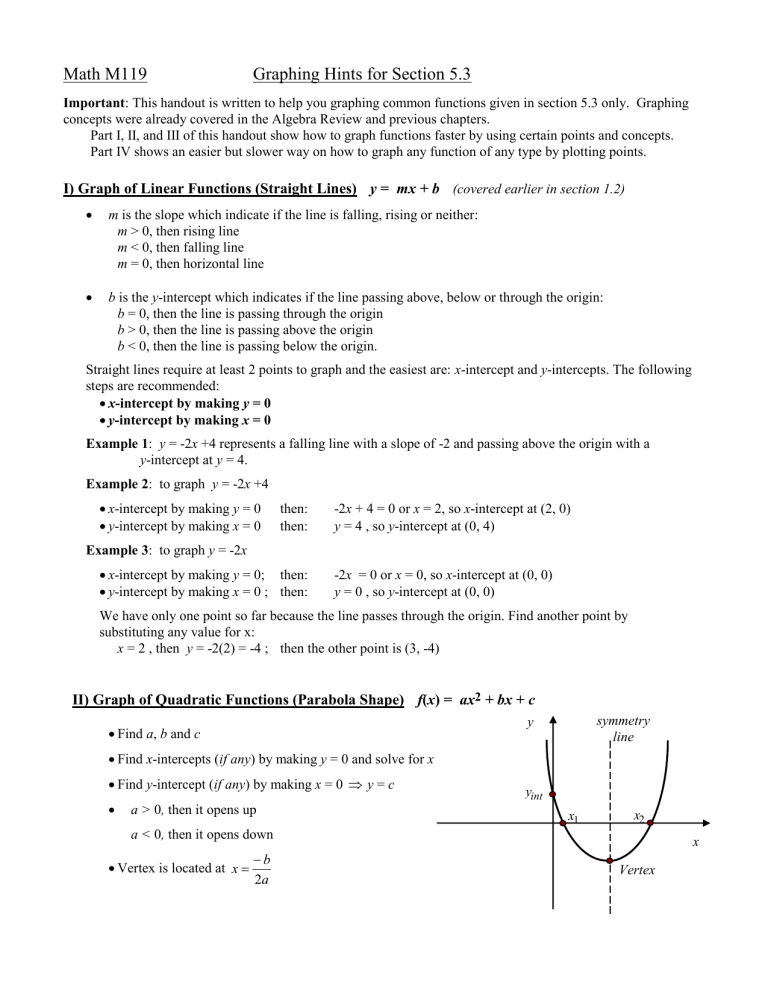
Math M119 Graphing Hints for Section 5.3
Important : This handout is written to help you graphing common functions given in section 5.3 only. Graphing concepts were already covered in the Algebra Review and previous chapters.
Part I, II, and III of this handout show how to graph functions faster by using certain points and concepts.
Part IV shows an easier but slower way on how to graph any function of any type by plotting points.
I) Graph of Linear Functions (Straight Lines)
y = mx + b (covered earlier in section 1.2)
m is the slope which indicate if the line is falling, rising or neither: m > 0, then rising line m < 0, then falling line m = 0, then horizontal line
b is the y -intercept which indicates if the line passing above, below or through the origin: b = 0, then the line is passing through the origin b > 0, then the line is passing above the origin b < 0, then the line is passing below the origin.
Straight lines require at least 2 points to graph and the easiest are: x -intercept and y -intercepts. The following steps are recommended:
x-intercept by making y = 0
y-intercept by making x = 0
Example 1 : y = -2 x +4 represents a falling line with a slope of -2 and passing above the origin with a y -intercept at y = 4.
Example 2 : to graph y = -2 x +4
x -intercept by making y = 0 then: -2 x + 4 = 0 or x = 2, so x -intercept at (2, 0)
y -intercept by making x = 0 then: y = 4 , so y -intercept at (0, 4)
Example 3 : to graph y = -2 x
x -intercept by making y = 0; then: -2 x = 0 or x = 0, so x -intercept at (0, 0)
y -intercept by making x = 0 ; then: y = 0 , so y -intercept at (0, 0)
We have only one point so far because the line passes through the origin. Find another point by substituting any value for x: x = 2 , then y = -2(2) = -4 ; then the other point is (3, -4)
II) Graph of Quadratic Functions (Parabola Shape)
f(x) = ax
2
+ bx + c
y
Find a , b and c symmetry line
Find x -intercepts ( if any ) by making y = 0 and solve for x
Find y -intercept ( if any ) by making x = 0
y = c
a > 0 , then it opens up y int x
1 x
2 a < 0 , then it opens down
Vertex is located at x
2 b a
Vertex x
Example 4:
Graph f(x) = x
2
+ 2x - 3
.
Find the vertex and any intercepts
a = 1, b = 2, c = -3
x -intercepts at y = 0, or x 2 + 2 x or ( x + 3)( x - 1) = 0
x = -3 and x = 1 x -intercepts at (-3, 0) and (1, 0)
- 3 = 0
y - intercepts at x = 0
y = -3 or at (0 , -3)
a > 0, then it opens up
Vertex at y
f (
1 ) x
b
2
2 ( 1 )
1 ;
2 a
4 or V(-1, -4)
Example 5:
Graph f(x) = 9 - x
2
This function can be rewritten as: f(x) = - x2 + 9
Find the vertex and any intercepts
(-3 , 0) symmetry line
Vertex
(-1,-4)
(0,9)
(1 , 0)
(0 ,-3)
a = -1, b = 0, c = 9
x -intercepts at y = 0 or 9 - x 2 = 0 ; or (3 x )(3 + x ) = 0
x = -3 and x = 3
y - intercepts at x = 0
y = 9 or at (0 , 9)
a < 0, then it opens down
Vertex at y
f x
b
2 a
2
0
( 0 )
9 or V(0, 9)
0 ;
Example 6:
Graph f(x) = x
2
+ 4
Find the vertex and any intercepts
(0 ,-3) (0 ,3)
a = 1, b = 0, c = 4
x -intercepts at y = 0 or x 2 + 4 = 0 or x 2 = - 4; not possible, so there are no x -intercepts
y - intercepts at x = 0
y = 4 or at (0 , 4)
a > 0, then it opens up
Vertex at x y
f
b
0
2 a 2 ( 1 )
( 0 )
4 or V(0, 4)
0 ;
(0,4)
More points are needed since we have only one point so far. Try x = -1, +1, -2 and +2 and substitute to get the following points: (-1, 5), (1, 5) , (-2, 8) and (2, 8).
2
III) Graphing Quadratic and Linear Functions in the Same xy-Plane
Linear function : find the x -intercepts and y -intercepts or more points (see example 2 and 3)
Quadratic function : find the x -intercepts, y -intercepts (see example 4, 5 and 6)
Intersection Points : find the intersection points between the two functions by equating the two functions y = y and then solve for x
Example 7:
Graph f ( x )
2 x
1 and g ( x )
x
2
4
Linear function : y
2 x
1 x -intercepts or y = 0, then x = 1/2 or (1/2, 0) y -intercepts or x = 0, then y = -1 or (0, -1) y = x
2- 4
Quadratic function : y
x
2
4 x -intercepts or y = 0, then x = -2, +2 or (-2, 0) , (2, 0) y -intercepts or x = 0, then y = -4 or (0, -4)
Intersection Points : find the points of intersection of the two curves by equating the two equations : x
2
4
2 x
1
( x x
2
2 x
1 )( x
3
3 )
0
0
Then x = -1 or x = 3 or (-1 , -3) and (3, 5)
So far we have 7 points and 2 of them are shared by both functions
( -2 , 0 )
( -1 , -3 ) y
(1/2,0)
( 0 , -1 )
( -4 , 0 ) y = 2 x -1
( 3 , 5 )
( 2 , 0 )
IV) Graphing Any Function by Plotting Points
Example 8:
Graph f ( x )
2 x
1 .
Linear function or straight line, so 2 points are enough. However, it is recommended to try 3 or 4 points to check your graph where all points must be on a straight line. x
0
2 y
2 x
1
1
3 y y = 2 x -1
Graph the straight line that passes through (0, -1) and
(2, 3)
If you try and plot more points, they will be on the same straight line.
(0, -1)
( 2 , 3 ) x x
3
Example 9
: Graph f ( x )
x
2
2 x
3 .
Quadratic function or parabola. The more points you try, the more accurate the graph will be, and make sure you try negative and positive points . x
0
1
1 y
x
2
3
2 x
3
0
4
5
3
2
2
3
3
4
12
0
5
Example 10
: Graph f ( x )
x .
It is not possible to have negative values for x . x
1
0
1
4 y
N .
P .
x
0
1
2
9 3
Example 11
: Graph f ( x )
x
3 x .
Try negative and positive points and some decimal points between. x y
x
3 x
0
1
0
0
1
2
2 6
Three points give value of zero, so we need a decimal point between.
0 .
x
5
0 .
5 y
x
3
0 .
375 x
0 .
375
0
6 y y y x x x
4
